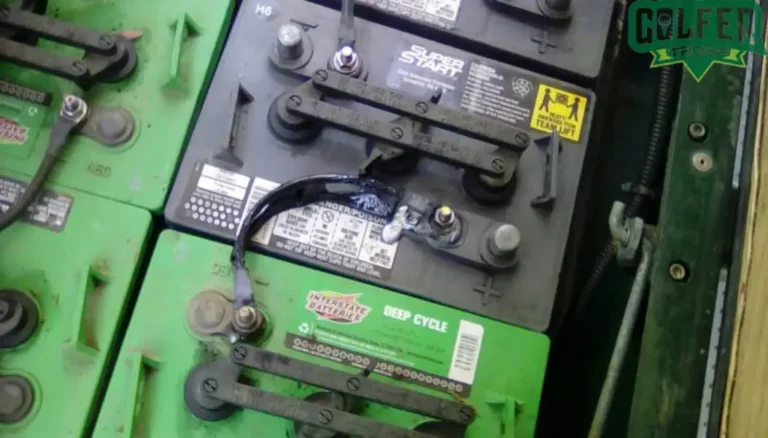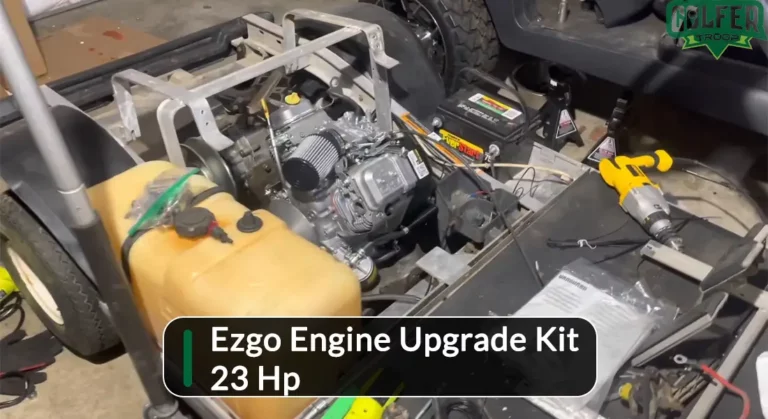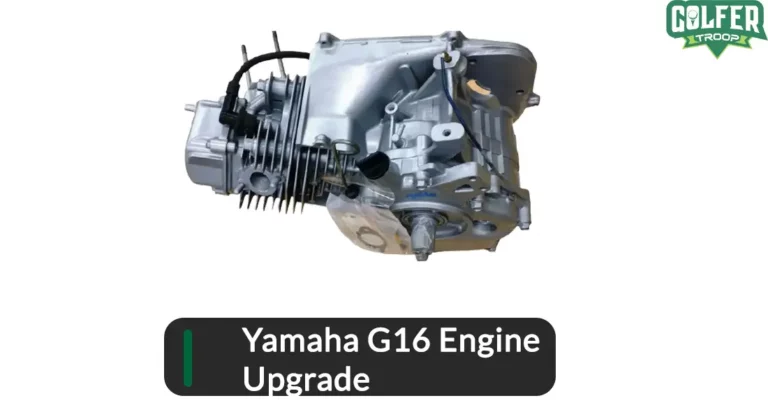EZGO Golf Cart Carburetor Adjustment: A Step-By-Step Guide
EZGO has golf carts that run both on electric and gas. You will choose the gas-powered ones if you want a sturdy cart with great longevity. However, these vehicles also come with a carburetor. The carb is a fairly complex machine and requires adjustments from time to time.
You might find your cart engine misfiring when the carburetor needs adjusting. Misfiring means the air-fuel ratio in the combustion chamber is off. In this case, you must adjust the ratio by tuning your carburetor’s air-fuel mixture screw. Some technicians call this process carb adjustment.
You should perform a carb adjustment as soon as required. Otherwise, your engine will be at stake. Learn about the symptoms and how to perform the procedure.

How To Know That Your EZGO Carb Needs Adjustment?
Multiple symptoms tell you that your EZGO cart’s carburetor is suffering. A bad carburetor will eventually destroy your engine.
In the meantime, you will be losing money on fuel in So, so you must recognize these symptoms and take early action.
If your golf cart is showing any of these signs below, you might need to adjust the carburetor (in some cases, replacements are required) –
- The cart is constantly exhausting thick black smoke.
- Makes unusual noises when the engine idles.
- Your engine frequently overheats.
- The golf cart cannot accelerate as it used to.
- You are losing more fuel than usual.
- When you start the car, there is a mild explosion.
- The cart struggles during reduced or increased speed.
How To Adjust Your EZGO Carburetor?
Adjusting your EZGO carburetor mostly means re-tuning the air-fuel mixture screw. The carb’s job is to maintain an accurate air-fuel ratio for the golf cart’s internal combustion engine.
If the screw is maladjusted, this ratio will alter and cause engine misfiring. Here’s how you correct it.
Step 1: Warm Up the Engine

Put your key in the EZGO cart’s ignition and turn it. After the engine starts, let it run for five minutes.
This will warm up the system to its general operating temperature. You always have to make carb adjustments on a warm car.
Because the process requires you to tune the screw with the noise you hear from the idling engine. Since you are working near a heated engine, wear your safety gloves.
Step 2: Accessing the Carburetor

You must remove your EZGO cart seat to access the engine compartment. This might vary slightly across models.
Once you access the compartment, locate the carburetor near the intake air hose. You will also notice a vacuum hose coming out from it.
Step 3: Identify the Air-Fuel Adjustment Screw
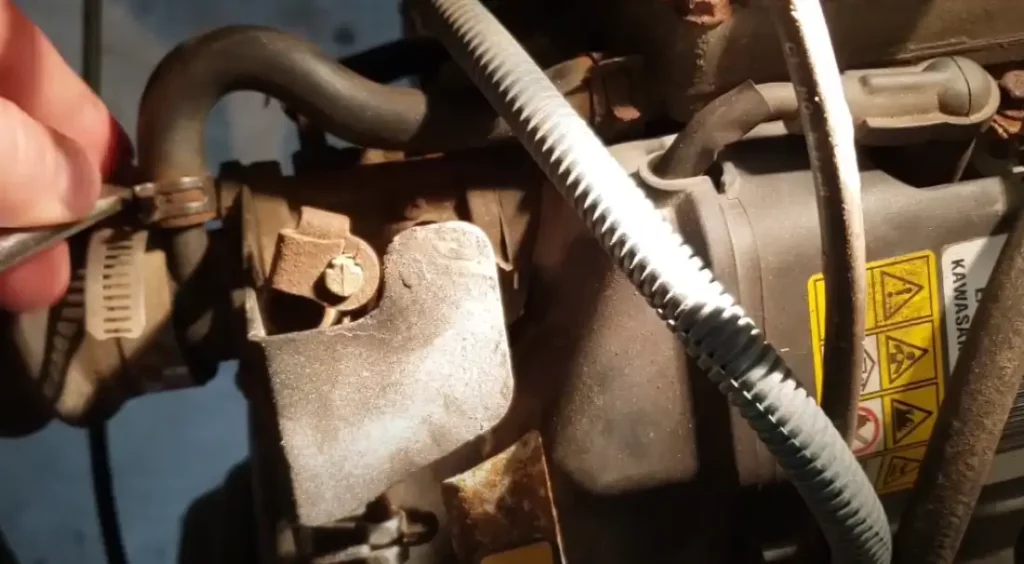
The air-fuel adjustment screw controls the amount of fuel available for combustion. A maladjusted screw lets in either too much or too little fuel.
And these give rise to faulty carburetor symptoms. You can usually adjust them with a flathead screwdriver.
You have to identify the adjustment screw correctly. Otherwise, you might tighten or loosen a similar structure and mess up the carburetor even further.
EZGO golf carts have 2-cycle and 4-cycle engines. The position of the air-fuel mixture screw is different for both types.
In a 2-cycle engine, the adjustment screw is at the side of the carburetor. From your point of view, it will be perfectly horizontal.
You will also notice a lock nut at the screw’s base. You need to loosen the nut before you tune the screw.
On a 4-cycle engine, the screw’s position is at the top of the carburetor. In other words, it’s perfectly vertical.
You will find that the screw wears a plastic cap limiter. Due to this difference, the 4-cycle screw needs fewer adjustments than the 2-cycle one.
Step 4: Tuning The Screw
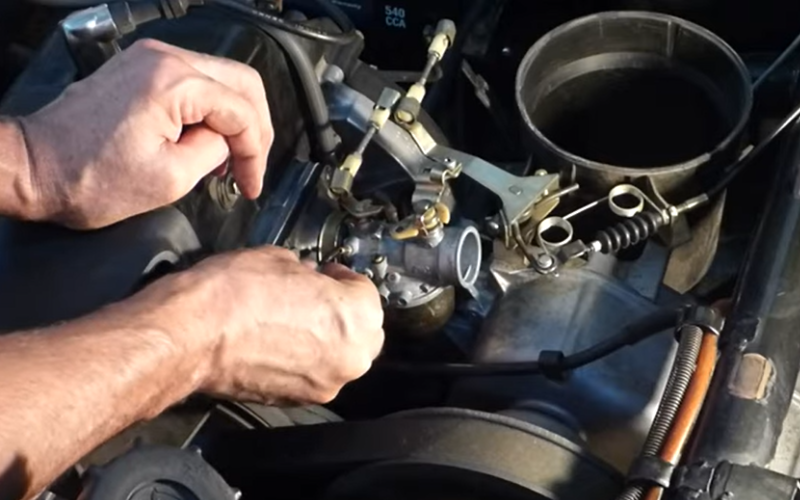
To tune the screw, you start turning it clockwise. In other words, you will be tightening the screw. Meanwhile, listen carefully to the idle engine.
The engine will start making a rough and somewhat rhythmic noise at one point. Stop tightening the screw when this happens.
As you tightened the screw, the entry of fuel into the engine got cut off. That’s the reason behind the noise.
Now start loosening the screw. Which means you will be turning your screwdriver anti-clockwise. This step requires your special attention. You will be counting each rotation as you turn the screw.
As the air-fuel adjustment screw loosens, more fuel enters the engine than it needs. As a result, the engine starts to sound irregular again. It almost feels like the idle engine is accelerating.
When you reach this point, stop loosening the screw. Remember the total number of rotations.
Step 5: Setting the Air-Fuel Adjustment
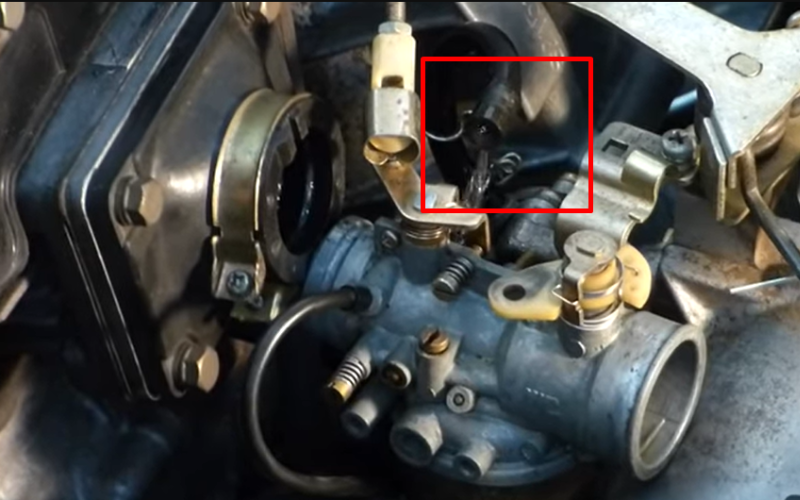
From the last point, start to turn the screw clockwise again. Set it midway between the last two points.
To do this accurately, remember the total number of rotations in the last step and divide it by two. Then, make that same number of clockwise rotations.
For instance, in an older 2-cycle engine, you might have made three anti-clockwise rotations in total. So, to reach the intended spot, you will make one and a half clockwise rotations.
If the idle engine sounds smooth enough in that middle position, set the screw there (using the lock nut or the limiter cap). You can also make a half-rotation in either direction to see if it makes the sound even smoother.
Some Common EZGO Carburetor Issues?
Your EZGO carburetor symptoms shall hopefully disappear once you adjust the air-fuel mixture screw. However, in some cases, they might still persist.
This indicates there’s a problem in some specific part of the carb. Let’s look at some such common EZGO carburetor issues.
Bad Low-Speed Jet and Pilot Screw
Two things can be responsible if your golf cart performs poorly at low speeds. Firstly, there might be a problem with the low-speed jet.
This jet provides fuel to your engine when running at low speed. So, a blocked or loose jet will hamper your cart’s low speed performance.
Another reason might be a maladjusted pilot screw. The air-fuel mixture screw controls the entry of fuel. Similarly, the pilot screw oversees how much air gets into the mixture.
If a typical carb adjustment doesn’t solve your low speed performance issue, consider adjusting the pilot screw.
Float Chamber Problems
If a problem exists within the float chamber and float pin, there will be gas leakage from your EZGO cart. In this case, only adjusting the air-fuel screw wouldn’t solve the problem.
The float chamber is essentially a bowl that reserves a certain fuel level in your carb. A floating pin is engaged with the chamber to regulate fuel entry and thus maintain the level.
If the pin’s damaged or the bowl is maladjusted, the fuel level will be disturbed. Subsequently, there will be gas leakage. The same can happen if the float chamber’s gasket breaks.
Replacement of the float bowl and chamber might be necessary in this case. Usually, the entire float kit will cost you around 60$ or upwards.
Air Filter issues
The air filter is an important accessory to your golf cart’s carburetor. It keeps the air-fuel mixture clean and pure for combustion.
Otherwise, dirt and debris would have found their way to your engine and severely damaged the whole system. Which is what happens when your filter is dirty or worn out.
A dirty air filter can manifest in two ways. You will find that your EZGO cart is having difficulty speeding up.
Plus, there might be more fuel loss than usual. Even after adjusting the carb, these problems will persist. So, the solution is to clean or replace the filter.
Expert Tips To Follow When Adjusting EZGO Carburetor
When adjusting your EZGO carburetor, there are a few tips to keep at the back of your mind. These will help you perform the process more accurately and safely-
- Always perform the EZGO carb adjustment on level ground.
- If you lose track while counting the rotations, start fresh.
- If you need to clean the carb, turn off the engine and let it completely cool down.
- After every 250 hours (or annually), perform a valve adjustment.
- Perform a carb adjustment as soon as required; otherwise, your engine will suffer irreversible damage.
- Empty the chamber and get new fuel if adjusting the screw doesn’t correct the air-fuel ratio.
FAQ on EZGO Golf Cart Carburetor Adjustment
The above discussion tried to cover all aspects of an EZGO carb adjustment. But still, there might be some queries that need answering. So, feel free to ask us here.
Where are the pilot screws and main jet of an EZGO carburetor?
You will find the main jet at the bottom of the carburetor. In contrast, the pilot screw takes its position at the top. The float pin is also at the bottom of the carburetor.
How do I know if there is proper compression in the EZGO carburetor?
You will have proper compression when the valve adjustment is right. To check it, you will need a compression tester. Take out the plugs of the valve and insert the tester.
Now, push down the gas pedal for three-quarters of a second. If the tester reads 160 pounds or more, the compression’s right.
How much does replacing the EZGO carburetor cost?
Typically a carburetor for an EZGO golf cart costs between 50-60$. You will also have to pay some labor charges if you cannot do the replacement yourself. These charges vary according to service shops.
How can I know if my EZGO has a two or four-cycle carburetor?
To determine the type of carburetor you have (during a replacement, adjustment, or repair), you need to identify the model of your EZGO. There are eight types of EZGO models. Among them, Medalist and TXT have four-cycle engines.
Conclusion
An EZGO carb adjustment might seem complex at first. There are too many jets, screws, and valves to keep up with. However, they all have a single purpose- to provide the perfect air-fuel mixture (14.7:1) for combustion.
In other words, all your carb adjustments and repairs happen based on the air-fuel mixture (14.7:1). Don’t obsess over the parts. Instead, pay attention to whether the engine receives a balanced and non-contaminated input.
So, checking the quality of the input is the most important part of investigating an EZGO carb issue. The carburetor isn’t your culprit if the engine is underperforming despite a good air-fuel ratio.
- Read Also: How to Fix EZGo Golf Cart Charging Problems? [Easy Fixes]
- Read Also: What Are the Most Common Issues With EZGo Gas Golf Carts?
- Read Also: How Do You Remove the EZGo Driven Clutch? [7 Easy Steps]
- Read Also: EZ Go Golf Cart Fuse Box Location [Fix a Blown Fuse]
- Read Also: EZgo Electric Golf Cart Won’t Move: How to Fix the Problems?
Meet Jalal, a passionate golf writer and the driving force behind Golfertroop.com, your go-to destination for all things golfing! Whether you’re a seasoned golfing veteran or a beginner taking your first swing, Jalal is here to assist you in making the most out of your golfing experience.


